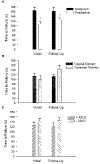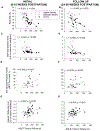Fatigability of the Lumbopelvic Stabilizing Muscles in Women 8 and 26 Weeks Postpartum
- PMID: 30740039
- PMCID: PMC6366649
- DOI: 10.1097/JWH.0000000000000109
Fatigability of the Lumbopelvic Stabilizing Muscles in Women 8 and 26 Weeks Postpartum
Abstract
Background: Pregnancy and childbirth are associated with lumbopelvic pain and instability. Fatigability of the lumbopelvic stabilizing muscles after childbirth is unknown, and no clinical tests exist to assess this important metric of muscle function.
Objectives: To compare fatigability of the lumbopelvic stabilizing muscles in postpartum and nulligravid (control) women using the Active Straight Leg Raise (ASLR) Fatigue Task, and to determine if fatigability is associated with inter-recti distance (IRD), physical function, and pain/disability.
Study design: Longitudinal case-control study.
Methods: Twenty-nine nulligravid (25.4 ± 9.1 years) and 31 postpartum women (31.4 ± 5.2 years; vaginal delivery n=18) were tested at two time points, 16 weeks apart (postpartum women tested at 8-10 and 24-26 weeks postpartum). Muscular function was assessed with manual muscle testing (MMT), the ASLR Test, and a new ASLR Fatigue Task. Other measures included IRD, rectus abdominis thickness, physical activity, and six-minute walk distance.
Results: Postpartum women were 23% more fatigable (p=0.028) and were weaker (MMT) (p<0.001) than controls up to 26 weeks postpartum. The ASLR fatigue task (time-to-failure) was associated with smaller IRD, greater rectus abdominis thickness, higher physical activity levels, greater MMT strength, and further distance walked in six minutes (p<0.05).
Conclusion: Postpartum women (up to 6 months) had greater fatigability of the lumbopelvic stabilizing muscles and lower physical function than nulligravid women, suggesting core muscle function and fatigability should be assessed after pregnancy and childbirth. The ASLR Fatigue Task could be a clinically useful tool to determine fatigability of the lumbopelvic stabilizing muscles in women postpartum.
Keywords: Abdominal muscles; pregnancy; women’s health.
Figures



Similar articles
-
Impaired Trunk Flexor Strength, Fatigability, and Steadiness in Postpartum Women.Med Sci Sports Exerc. 2018 Aug;50(8):1558-1569. doi: 10.1249/MSS.0000000000001609. Med Sci Sports Exerc. 2018. PMID: 29554014 Free PMC article.
-
The relationships between inter-recti distance measured by ultrasound imaging and abdominal muscle function in postpartum women: a 6-month follow-up study.J Orthop Sports Phys Ther. 2011 Jun;41(6):435-43. doi: 10.2519/jospt.2011.3507. Epub 2011 Feb 2. J Orthop Sports Phys Ther. 2011. PMID: 21289454
-
Ultrasound characteristics of the deep abdominal muscles during the active straight leg raise test.Arch Phys Med Rehabil. 2009 May;90(5):761-7. doi: 10.1016/j.apmr.2008.11.011. Arch Phys Med Rehabil. 2009. PMID: 19406295
-
Immediate Effect of Kinesio Taping on Lumbopelvic Stability in Postpartum Women With Diastasis Recti: A Review.Cureus. 2023 Jan 4;15(1):e33347. doi: 10.7759/cureus.33347. eCollection 2023 Jan. Cureus. 2023. PMID: 36751171 Free PMC article. Review.
-
The effect of myofascial therapy on postpartum rectus abdominis separation, low back and leg pain, pelvic floor dysfunction: A systematic review and meta-analysis.Medicine (Baltimore). 2023 Nov 3;102(44):e35761. doi: 10.1097/MD.0000000000035761. Medicine (Baltimore). 2023. PMID: 37932976 Free PMC article.
Cited by
-
The effect of pregnancy and the duration of postpartum convalescence on the physical fitness of healthy women: A cohort study of active duty servicewomen receiving 6 weeks versus 12 weeks convalescence.PLoS One. 2021 Jul 28;16(7):e0255248. doi: 10.1371/journal.pone.0255248. eCollection 2021. PLoS One. 2021. PMID: 34320030 Free PMC article.
-
The Combined Influence of Infant Carrying Method and Motherhood on Gait Mechanics.J Appl Biomech. 2023 Nov 20;40(2):105-111. doi: 10.1123/jab.2023-0127. Print 2024 Apr 1. J Appl Biomech. 2023. PMID: 37984353 Free PMC article.
-
The Relationship between Abdominal Diastasis and Lumbar Pain Pressure Threshold in Women Who Have Given Birth between the Ages of 30 and 45 Years-An Observational Pilot Study.Medicina (Kaunas). 2024 Apr 3;60(4):591. doi: 10.3390/medicina60040591. Medicina (Kaunas). 2024. PMID: 38674236 Free PMC article.
-
Common musculoskeletal impairments in postpartum runners: an international Delphi study.Arch Physiother. 2020 Oct 26;10:19. doi: 10.1186/s40945-020-00090-y. eCollection 2020. Arch Physiother. 2020. PMID: 33117595 Free PMC article.
-
Fatiguing Trunk Flexor Exercise Decreases Pain Sensitivity in Postpartum Women.Front Physiol. 2019 Mar 26;10:315. doi: 10.3389/fphys.2019.00315. eCollection 2019. Front Physiol. 2019. PMID: 30971949 Free PMC article.
References
-
- Parker M, Millar A. Diastasis Rectus Abdominis and Lumbo-Pelvic Pain and Dysfunction-Are They Related? Journal of Women’s Health Physical Therapy. 2008;32(1):15–22.
-
- Ahn S, Youngblut J. Predictors of women’s postpartum health status in the first 3 months after childbirth. Asian Nursing Research. 2007;1(2):136–146. - PubMed
-
- MacLennan A, Taylor A, Wilson D, Wilson D. The prevalance of pelvic floor disorders and their relationship to gender, age, parity and mode of delivery. British Journal of Obstetrics and Gynaecology. 2000;107:1460–1470. - PubMed
-
- Gutke A, Ostgaard H, Oberg B. Association between muscle function and low back pain in relation to pregnancy. Journal of Rehabilitation Medicine. 2008;40:304–311. - PubMed
Grants and funding
LinkOut - more resources
Full Text Sources
